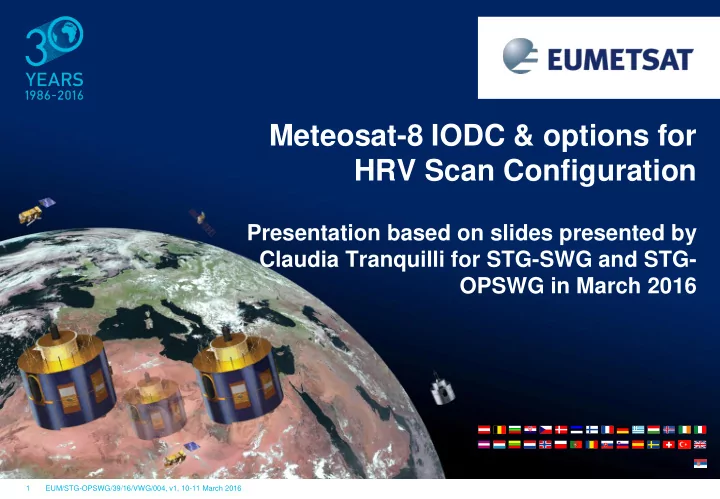

Meteosat-8 IODC & options for HRV Scan Configuration Presentation based on slides presented by Claudia Tranquilli for STG-SWG and STG- OPSWG in March 2016 1 EUM/STG-OPSWG/39/16/VWG/004, v1, 10-11 March 2016
MSG-IODC project – an overview • The MSG-IODC (Indian Ocean Data Coverage) project has been established to coordinate the activities necessary to relocate Meteosat-8 (MSG-1) over the Indian Ocean and to establish the “MSG” IODC services. • Moving the satellite still requires approval by the various Delegate Body meetings. • The preparatory work (feasibility & technical analyses) is planned to be completed by the end of June in anticipation of a positive decision from the summer Council. • This would allow the start of the drift of Meteosat-8 to 41.5 ° E to be initiated in July. 2 EUM/STG-OPSWG/39/16/VWG/004, v1, 10-11 March 2016
MSG-IODC project – scope and background (1) • EUMETSAT now has four MSG satellites in orbit after the successful launch and commissioning of Meteosat- 11 (MSG-4). • Meteosat-9, at 0 ° prime mission, Full Disk Service • Meteosat-10, at 9.5 ° E Rapid Scanning Service • Meteosat-11, stored in orbit • Meteosat-8, the oldest MSG satellite in orbit, available to support IODC service until at least April 2019. • Pending Council approval in June 2016, EUMETSAT will relocate the Meteosat-8 satellite to 41.5 ° E longitude. • It will replace the 19-year-old Meteosat-7, currently located at 57.5 ° E, which will be sent to the graveyard orbit in spring 2017. 3 EUM/STG-OPSWG/39/16/VWG/004, v1, 10-11 March 2016
MSG-IODC project – scope and background (2) • Once arrived at 41.5 ° E in September 2016, Met-8 will undergo a number of tests. • About two months of parallel operations for Met-7 and Met-8, with data dissemination to users. The start of the Met-8 IODC operational service expected in early 2017. • The start of the operations of Met-8 over the Indian Ocean region will mark an important change for the services provided to users – a transition from the 1 st to the 2 nd generation Meteosat satellites. • Will provide a significant improvement in the service, offering a wider suite of products, more channels, an enhanced image spatial resolution and a shorter repeat cycle. 4 EUM/STG-OPSWG/39/16/VWG/004, v1, 10-11 March 2016
Proposed Services – Image Data • Full Earth scan - 12 channels/15 Minutes • Covering ~40 ° West to ~120 ° East • HRV Scan pattern see later slides View from 41.5 deg 5 EUM/STG-OPSWG/39/16/VWG/004, v1, 10-11 March 2016
Proposed Service – Meteorological Products Product Number/ Product Number/ Product Name Product Name Acronym Day Acronym Day Active Fire Monitoring FIR 96 Divergence DIV 24 Aerosol Over Sea AES 1 Global Instability Index GII 96 High Resolution Precipitation Atmospheric Motion Vectors AMV 24 HPI 1 Index Multisensor Precipitation All-Sky Radiances ASR 24 MPE 96 Estimate Normalized Difference Clear-Sky Radiances CSR 24 NDVI 1 Vegetation Index Normalized Difference Clear Sky Reflectance Map CRM 1 NDVI-D 1/10 days Vegetation Index – decadal Climate Data Set CDS 96 Optimal Cloud Analysis OCA 24 Cloud Analysis CLA 24 Tropospheric Humidity TH 24 Cloud Analysis Image CLAI 8 Total Ozone TOZ 96 Cloud Mask CLM 96 0 96 (netCDF) Volcanic Ash VOL (CAP-on Cloud Top Height CTH 96 request) ( Italic: only to Data Centre gray background: common MTP & MSG) 6 EUM/STG-OPSWG/39/16/VWG/004, v1, 10-11 March 2016
Meteosat-7 – Meteosat-8 – Meteosat-10 Earth views Illustrating the visible Overlap between Meteosat-8 @ 41.5 ° East with Meteosat-7 @ 57.5 ° East and Meteosat-10 @ 0.0 ° 7 EUM/STG-OPSWG/39/16/VWG/004, v1, 10-11 March 2016
HRV Scan configuration • Changing the view of the Earth from the spacecraft implies the identification of a strategy for the monitoring with regards to the HRV channel over the Indian Ocean; • This topic has been matter of discussion in the EUMETSAT delegate body meetings in 2015 • EUM secretariat has been tasked to investigate various HRV strategies for proposal in the 2016 round of meetings 8 EUM/STG-OPSWG/39/16/VWG/004, v1, 10-11 March 2016
Current HRV Strategy for 0 deg FES mission For 0 ° FES mission, the current strategy for HRV is: HRV window split at line 914 (North Africa); Upper window over Europe, moving twice a day, at 17:00 UTC westward (≈ 973 km) and at 00:00 UTC back to initial position; Lower window over Africa, moving five times a day following Sun illumination (at 14, 15, 16, 17 ≈1434 km per shift, then back to initial position at 00:00 UTC). 9 EUM/STG-OPSWG/39/16/VWG/004, v1, 10-11 March 2016
Meteosat-10 HRV Window Shift (0 deg) 00: 15: 14: 16: 17: 00: 10 EUM/STG-OPSWG/39/16/VWG/004, v1, 10-11 March 2016
Following the Sun at 41.5 ° East To maximize the IODC coverage following the Sun, the HRV window should be shifted westwards at the following times Westward movement 15 ms Time DELAY [ClkP]* [≈km] [UTC] 12:00 14336 1434 13:00 28672 2867 14:00 43008 4301 15:00 55808 5581 22:00 0 0 *(10 ClkP ≈ 1 km) 30 ms 11 EUM/STG-OPSWG/39/16/VWG/004, v1, 10-11 March 2016
IODC HRV Option #2 (following terminator – no split) 00:00 14:00 13:00 17:00 12:00 17:00 15:00 11:00 16:00 21:00 14:00 00:00 EAW IODC HRVW IODC HRVW 0 deg 12 EUM/STG-OPSWG/39/16/VWG/004, v1, 10-11 March 2016
Assessments • Option#1 maximizes the IODC coverage during illuminated hours; • Option#2 anticipates the overlap of the area already covered by the 0 deg mission; • Option#3 uses the lower HRV window maximising IODC and HRV AMV generation, and the upper window to maximise coverage and use over land thanks to the synchronisation with the 0 deg mission upper HRV window. 13 EUM/STG-OPSWG/39/16/VWG/004, v1, 10-11 March 2016
Conclusions • EUMETSAT plans to start IODC parallel operations using either options #1, #2 or #3 14 EUM/STG-OPSWG/39/16/VWG/004, v1, 10-11 March 2016
Recommend
More recommend